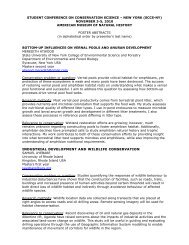Coloring Book - American Museum of Natural History
Coloring Book - American Museum of Natural History
Coloring Book - American Museum of Natural History
- No tags were found...
You also want an ePaper? Increase the reach of your titles
YUMPU automatically turns print PDFs into web optimized ePapers that Google loves.
North <strong>American</strong> Mammals<strong>Coloring</strong> <strong>Book</strong>From antelope to armadillo and moose to mouse, more than 500 mammal specieslive in North America today. We can find them in every habitat on the continent,from the treeless tundra <strong>of</strong> the Arctic to the cypress swamps <strong>of</strong> the tropics.The <strong>Museum</strong>’s Bernard Family Hall <strong>of</strong> North <strong>American</strong> Mammals has some <strong>of</strong>the most famous dioramas in the world. They show mammals living in theirenvironments. Explore six <strong>of</strong> them in this coloring book.amnh.org/ology© <strong>American</strong> <strong>Museum</strong> <strong>of</strong> <strong>Natural</strong> <strong>History</strong>. All rights reserved.
Alaska Brown BearLate Spring • Canoe Bay, AlaskaAlthough brown bears don’t mingle much, these two have gathered at a stream. They arelured by the salmon that swim upstream each summer. The nutrient-rich fish help thebears regain body mass after hibernating for the winter.Did You Know?Brown bears vary in size and color depending on where they live. Those on the AlaskaPeninsula coast and islands are the largest carnivores that live on land today. Brown bearsthat live inland (such as the grizzly bears) eat mainly plants — and can be half the size!amnh.org/ology© <strong>American</strong> <strong>Museum</strong> <strong>of</strong> <strong>Natural</strong> <strong>History</strong>. All rights reserved.
North <strong>American</strong> BeaverJuly Evening • Central MichiganThe beaver is the largest rodent on the continent and has teeth that are ever-growing.Beavers use their sharp teeth to cut down trees. They then use the timber to build large,elaborate nests inside ponds. Their nests are dome-shaped lodges with underwaterentrances. If there is no pond, beavers will create one by building a dam to block a stream.The moat around their lodges keeps wolves, coyotes, and other predators away.Did You Know?Beavers live both on land and in water. Adaptations such as closeable ears and nostrils,webbed hind feet, very dense fur coats, and paddlelike tails allowbeavers to be semi-aquatic.amnh.org/ology© <strong>American</strong> <strong>Museum</strong> <strong>of</strong> <strong>Natural</strong> <strong>History</strong>. All rights reserved.
Black-tailed and Antelope JackrabbitsJune at Noon • Near Tucson, ArizonaHere in the desert, the daysare hot and water is scarce.To help them stay cool, thejackrabbits resting here havelong ears with bloodvessels close to the skin toshed body heat. Their longlegs help keep them high<strong>of</strong>f the ground to stay cool.Antelope jackrabbits (right)are so well-adapted to watershortage that they neverneed to drink. They simplyeat water-storing plantslike cacti.Did You Know?In a race between thetwo hares, the antelopejackrabbit would win. It canreach speeds <strong>of</strong> 44 miles(72 kilometers) per hour!amnh.org/ology© <strong>American</strong> <strong>Museum</strong> <strong>of</strong> <strong>Natural</strong> <strong>History</strong>. All rights reserved.
WolfDecember at Midnight • Gunflint Lake, Northern MinnesotaThis wolf pack is chasing a deer that is running for its life. The pair may pursue the deerfor several miles to exhaust it, then bring it down in a joint effort. Group hunting is howwolves can prey on animals much bigger than themselves. Still, deer are fast. If the wolvescannot close in quickly, they will give up and follow the scent <strong>of</strong> another prey.Did You Know?All dogs evolved from wolves!amnh.org/ology© <strong>American</strong> <strong>Museum</strong> <strong>of</strong> <strong>Natural</strong> <strong>History</strong>. All rights reserved.
JaguarOctober at Sunset • Sonora, MexicoPoised on the edge <strong>of</strong> a canyon, the jaguars study a livestock corral in the shrubland below.They are seeking prey at dusk, which is typical for large predators. A jaguar’s muscular,compact frame is built for strength and stealth rather than long-distance running. Its jawscan crush the skulls <strong>of</strong> small mammals and can even pierce turtle shells. For larger prey, thejaguar pounces and brings down the victim by twisting [ok?] the head with a swipe <strong>of</strong> itswide paw.Did You Know?The jaguar is the largest cat in the Americas. They are almost always yellowy tan withblack spots called rosettes. Black jaguars are occasionally seen in rain forests. The rosettes<strong>of</strong> black jaguars are still faintly visible.amnh.org/ology© <strong>American</strong> <strong>Museum</strong> <strong>of</strong> <strong>Natural</strong> <strong>History</strong>. All rights reserved.
Dall SheepAugust at Midnight • Denali National Park, AlaskaCamouflaged against the snow, Dall sheep thrive where few mammals can. They live abovethe tree line on windy peaks in Alaska and northwest Canada. While predators like wolvesand bears do threaten, few enemies can pursue these nimble sheep up the very steepestcliffs. Dall sheep are also known as white sheep, yet they aren’t all white. The farther souththey live, the grayer they are.Did You Know?Horns are important for mating and defense. They grow on sheep, goats, musk oxen, andbison. (Antlers grow on deer, moose, wapiti, and caribou.) Horns are made from a kind <strong>of</strong>keratin, a hard protein, that grows continuously over a core <strong>of</strong> bone. Growth slows as thesheep ages; years are marked by distinct bands. The horns spiral because their sides growat different rates.amnh.org/ology© <strong>American</strong> <strong>Museum</strong> <strong>of</strong> <strong>Natural</strong> <strong>History</strong>. All rights reserved.
















